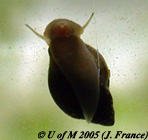
 |
Phylum Mollusca
Canadian Campbell 2nd ed. Pages 738 - 742
One of the largest and most familiar groups of invertebrates, the molluscs are characterized by having a ventral muscular foot, a dorsal fleshy mass containing the viscera and in most species a protective calcareous shell secreted by an underlying mantle layer. The ventral foot and the fleshy parts of the body show extreme modifications among the members of this phylum. Because of their soft fleshy bodies, the molluscs, more than any other invertebrates, are widely used as food by man. The molluscs contain the largest individuals (squid and octopus) of all invertebrates and this group also shows the greatest degree of nervous system organization. Included in this phylum are the snails, slugs, clams, chitons, squid and octopi.

Class Gastropoda (Snails and Slugs)
This is by far the largest class of molluscs. In all forms the viscera is enclosed in a coiled shell during the early stages of development. In most gastropods the coiled shell is retained in the adult, but in the slugs the shell has been lost.
Click here to view a drawing of a snail
Class Bivalvia (Clams, Oysters, etc.)
Freshwater mussels are abundently distributed and live on the bottom of lakes, rivers, ponds and streams, where they feed on small plant and animal life. The larval stage of the freshwater mussel is parasitic on the gills of fish. The shell of the clam consists of two valves hinged together along the dorsal side. On the anterior-dorsal part of each valve is a swollen region, the umbo. Concentric lines extend outward from the umbo and represent lines of growth. Freshwater mussels are extremely long lived with some species living over 80 years. The valves are held together by two large adductor muscles (anterior and posterior). The valves are lined by a membranous structure, the mantle . At the posterior margin the mantle is thickened and comes together to form two openings, the siphons. Water enters the clam through the ventral incurrent siphon, circulates through the mantle cavity and over the gills , and leaves through the dorsal excurrent siphon. A large muscular foot extends down from the visceral mass. Two pairs of gills hang down into the mantle cavity.
Click here to view a preserved fresh water mussel
The Cephalopoda have highly developed brains compared to other invertabrates. Note that the foot has been modified to form the tentacles.
![]()
